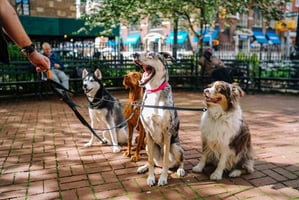Having a pet comes with a lot of responsibilities, and proper dental care is one of them. If you...
Dog Training at Home: How to Get Started
Training your dog at home can be a great way to save money and bond with your pet. However, there are certain techniques and strategies that you should know before getting started. This article will help you understand the basics of dog training at home, from setting up a safe environment to teaching basic commands.
Creating a Safe Training Environment
The first step to dog training at home is to create a safe environment for your pet. This means that you should remove any potential distractions or hazards such as furniture, toys, and other items that could interfere with your dog's training. You should also remove any items that your dog could chew or swallow, as this could be dangerous.
It's also important to make sure that your dog has plenty of space to move around in and that there is no risk of them escaping. If your dog is used to being outside, you should create a secure area in your yard or garden that they can use for training.
It's also important to have the right equipment on hand. This includes things like a leash, treats, and toys that you can use to reward your dog for good behaviour.
Teaching Basic Commands
Once you have created a safe environment for your pet, you can start to teach them basic commands. These commands are essential for keeping your dog safe and for ensuring that they understand your expectations. The most important commands to teach are:
- Sit
- Stay
- Come
- Down
- Heel
The best way to teach these commands is by using positive reinforcement. This means rewarding your dog with treats or praise when they do something correctly. You should also avoid punishing your dog for making a mistake, as this could have a negative effect on their training.
It's also important to be consistent with your commands. You should use the same words and phrases each time and make sure that everyone in your household follows the same rules.
Building on Basic Commands
Once your dog has mastered the basic commands, you can start to build on them. This includes teaching your dog more complicated commands such as “roll over”, “fetch”, and “speak”. You can also start to introduce them to more complex activities such as agility and obedience training.
It's important to keep in mind that different dogs learn at different speeds. Some may pick up commands quickly while others may take longer. It's important to be patient and to reward your dog for their progress.
It's also important to keep the training sessions short and fun. Long and boring sessions can be discouraging for your dog and may make them less likely to learn.
Troubleshooting Common Issues
Even with the right techniques, dog training at home can be challenging. Here are some of the most common issues that you may encounter and how to address them:
- Your dog is not responding to commands: Make sure that you are using the same words and phrases each time and that you are rewarding your dog when they do something correctly. You should also make sure that your dog is in a quiet and distraction-free environment.
- Your dog is not paying attention: Make sure that you are using treats and praise to reward your dog. You should also make sure that the training sessions are short and fun.
- Your dog is getting too excited: Try to keep the training sessions calm and relaxed. You should also avoid using too many treats or giving too much praise as this can make your dog too excited.
Conclusion
Dog training at home can be a great way to save money and bond with your pet. However, it's important to understand the basics of dog training and to create a safe environment for your pet. Once you have done this, you can start to teach your dog basic commands and build on them. Finally, it's important to be patient and consistent and to troubleshoot any common issues that you may encounter.



